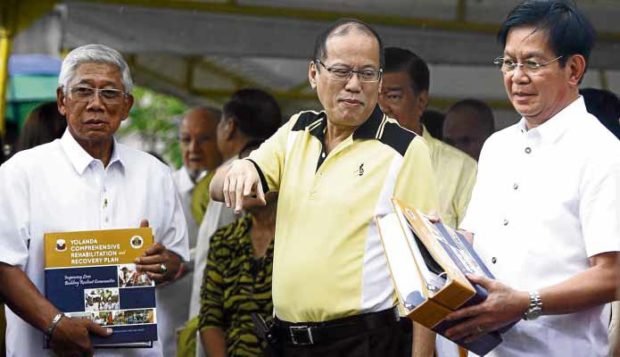Lacson, ex-rehab czar, decries lack of ‘Yolanda’ funds

REHAB MASTER PLAN Then President Benigno Aquino III receives a copy of the master plan for the rehabilitation of areas hit by Supertyphoon “Yolanda” from Panfilo Lacson, eight months after appointing the former police chief presidential assistant for rehabilitation and recovery in December 2013. —INQUIRER FILE PHOTO
Five years after Supertyphoon “Yolanda” (international name: Haiyan) devastated Eastern Visayas, Sen. Panfilo Lacson, who was tapped then to lead the rehabilitation efforts, reiterated his frustrations about the government’s failure to release funds promptly.
“A lot was accomplished, but no thanks to the government, but many thanks to the NGOs (nongovernment organizations) and private as well as business sector,” Lacson told reporters in a text message.
Yolanda, the worst storm on record to hit the Philippines, left some 7,350 people dead or missing, and damaged billions of pesos worth of property.
Lacson recalled funding bottlenecks that hampered his work in coordinating disaster-response work — from relief to recovery and reconstruction — in the affected places, especially in Leyte and Samar, which were the hardest hit provinces by the Nov. 8, 2013, typhoon.
He lamented the lack of government budgetary support in helping the distressed communities get back on their feet, even as billions of pesos in donations poured in from around the world.
Article continues after this advertisement“[Very] little budget support was appropriated to help the typhoon victims in the affected areas,” Lacson said.
Article continues after this advertisementIn December 2013, then President Benigno Aquino III appointed Lacson presidential assistant for rehabilitation and recovery.
Overall manager
Lacson was to be the overall manager and coordinator of the rehabilitation, recovery and reconstruction efforts of government departments and agencies in the affected areas.
But he announced his resignation a year later, complaining about how the Department of Budget and Management, headed then by Secretary Florencio Abad, “released funds in piecemeal and trickles.”
On Tuesday, the senator described his work as “extremely difficult, many times frustrating, yet satisfying only because I worked with very competent staff and consultants who didn’t mind the limitations imposed by our own government in all aspects.”
With the help of multinational agencies, such as the US Agency for International Development, United Nations Development Program, Japan International Cooperation Agency and World Bank, Lacson’s office put together an eight-volume, 8,000 page Comprehensive Rehabilitation and Recovery Plan with a P167-billion budgetary requirement.
“That document consisted of a detailed and elaborate description of the 5 Ws (what, why, where, when and how) in order to accomplish a build-back-better vision for the 171 cities and municipalities devastated by Yolanda, the senator said.
Unfortunately, according to Lacson, while the rehabilitation plan was approved by Aquino, there was no budget to go with it.